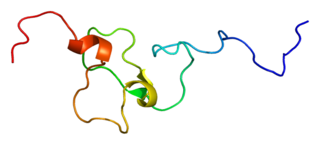RelA-associated inhibitor is a protein that in humans is encoded by the PPP1R13L gene. [5] [6]
RelA-associated inhibitor is a protein that in humans is encoded by the PPP1R13L gene. [5] [6]
PPP1R13L has been shown to interact with Sp1 transcription factor [7] and RELA. [5] [7]

p53, also known as Tumor protein P53, cellular tumor antigen p53, or transformation-related protein 53 (TRP53) is a regulatory protein that is often mutated in human cancers. The p53 proteins are crucial in vertebrates, where they prevent cancer formation. As such, p53 has been described as "the guardian of the genome" because of its role in conserving stability by preventing genome mutation. Hence TP53 is classified as a tumor suppressor gene.

Transcription factor Sp1, also known as specificity protein 1* is a protein that in humans is encoded by the SP1 gene.

p21Cip1, also known as cyclin-dependent kinase inhibitor 1 or CDK-interacting protein 1, is a cyclin-dependent kinase inhibitor (CKI) that is capable of inhibiting all cyclin/CDK complexes, though is primarily associated with inhibition of CDK2. p21 represents a major target of p53 activity and thus is associated with linking DNA damage to cell cycle arrest. This protein is encoded by the CDKN1A gene located on chromosome 6 (6p21.2) in humans.

The p53 upregulated modulator of apoptosis (PUMA) also known as Bcl-2-binding component 3 (BBC3), is a pro-apoptotic protein, member of the Bcl-2 protein family. In humans, the Bcl-2-binding component 3 protein is encoded by the BBC3 gene. The expression of PUMA is regulated by the tumor suppressor p53. PUMA is involved in p53-dependent and -independent apoptosis induced by a variety of signals, and is regulated by transcription factors, not by post-translational modifications. After activation, PUMA interacts with antiapoptotic Bcl-2 family members, thus freeing Bax and/or Bak which are then able to signal apoptosis to the mitochondria. Following mitochondrial dysfunction, the caspase cascade is activated ultimately leading to cell death.

IκBα is one member of a family of cellular proteins that function to inhibit the NF-κB transcription factor. IκBα inhibits NF-κB by masking the nuclear localization signals (NLS) of NF-κB proteins and keeping them sequestered in an inactive state in the cytoplasm. In addition, IκBα blocks the ability of NF-κB transcription factors to bind to DNA, which is required for NF-κB's proper functioning.

Transcription factor p65 also known as nuclear factor NF-kappa-B p65 subunit is a protein that in humans is encoded by the RELA gene.

The proto-oncogene c-Rel is a protein that in humans is encoded by the REL gene. The c-Rel protein is a member of the NF-κB family of transcription factors and contains a Rel homology domain (RHD) at its N-terminus and two C-terminal transactivation domains. c-Rel is a myeloid checkpoint protein that can be targeted for treating cancer. c-Rel has an important role in B-cell survival and proliferation. The REL gene is amplified or mutated in several human B-cell lymphomas, including diffuse large B-cell lymphoma and Hodgkin's lymphoma.

M-phase inducer phosphatase 3 is an enzyme that in humans is encoded by the CDC25C gene.

ATP-dependent RNA helicase A is an enzyme that in humans is encoded by the DHX9 gene.

Protein Mdm4 is a protein that in humans is encoded by the MDM4 gene.

Apoptosis-stimulating of p53 protein 2 (ASPP2) also known as Bcl2-binding protein (Bbp) and tumor suppressor p53-binding protein 2 (p53BP2) is a protein that in humans is encoded by the TP53BP2 gene. Multiple transcript variants encoding different isoforms have been found for this gene.

Transducin-like enhancer protein 1 is a protein that in humans is encoded by the TLE1 gene.

Polo-like kinase 3 (Drosophila), also known as PLK3, is an enzyme which in humans is encoded by the PLK3 gene.

Cyclin-dependent kinase inhibitor 3 is an enzyme that in humans is encoded by the CDKN3 gene.

Inhibitor of growth protein 4 is a protein that in humans is encoded by the ING4 gene.

60S ribosomal protein L23 is a protein that in humans is encoded by the RPL23 gene.

Apoptosis-stimulating of p53 protein 1 is a protein that in humans is encoded by the PPP1R13B gene.

LIM domain only protein 3 is a transcription co-factor, which in humans is encoded by the LMO3 gene. LMO3 interacts with the tumor suppressor p53 and regulates its function. LMO3 is considered to be an oncogene in Neuroblastoma.
Xin Lu is a Professor of Cancer Biology and Director of the Ludwig Institute for Cancer Research at the University of Oxford. She is known for her discovery of and research on the ASPP family of proteins.

TSPY like 5 is a protein that in humans is encoded by the TSPYL5 gene.